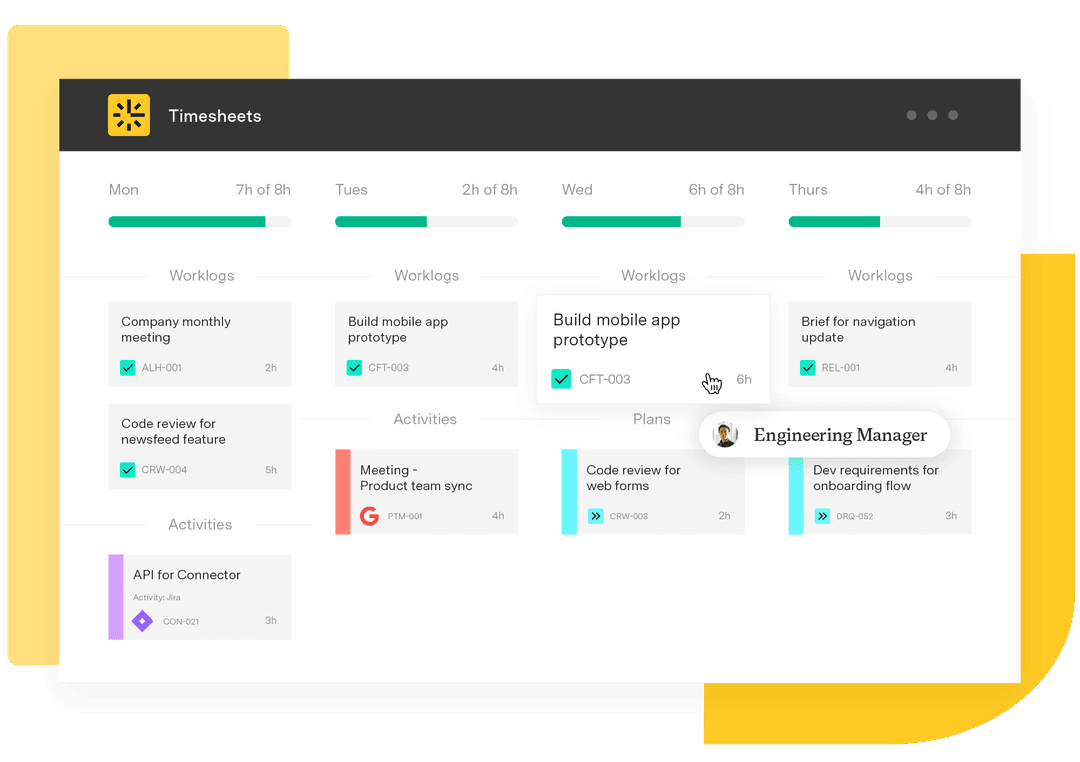12 lessons learned templates for project reviews
Tempo Team
Projects rarely unfold exactly as planned, even for the most prepared teams. Deadlines shift, resources run thin, and unexpected challenges emerge. But every project, whether a success or a flop, is an opportunity to reflect and improve.
A lessons learned template gives project teams a structured way to capture insights. They feed your organization’s continuous improvement process, turning each outcome into better planning for future endeavors.
In this guide, we’ll explain what a lessons learned template is, highlight the benefits of using one, and share practical templates to consider the next time your team reviews a project.
What’s a lessons learned template?
A lessons learned template, sometimes called a postmortem template, is a standardized document that teams use during and after a project to capture what went well, what challenges came up, and what to improve. It’s a record for reflection, with space to analyze areas for improvement and gather feedback that supports organizational learning.
Beyond documenting insights, a lessons learned template builds a centralized knowledge base that helps teams repeat successes and avoid mistakes. For project managers, it serves as a practical tool that strengthens processes and drives continuous improvement.
Benefits of using a lessons learned template
A lessons learned template does more than document a project after the dust settles. It gives teams a consistent way to capture feedback, analyze results, and share insights. That process builds valuable knowledge that gives your next project a stronger chance at success.
Below are some key benefits of using a project review template.
Fosters a culture of continuous improvement
Instead of relying on one person’s memory or scattered notes, a lessons learned template gathers feedback in one place. With repeated use, teams naturally reflect on both wins and setbacks until the practice is part of daily operations.
Improves future project planning
A lessons learned template helps project managers plan the next initiative with more accuracy. Teams can review past timelines, resource allocation, and pitfalls and then adjust future plans based on real data instead of guesswork.
Prevents recurring mistakes
One of the most important benefits of a lessons learned template is that it prevents mistakes from repeating. By flagging past errors, it gives teams practical guidance for avoiding them on future projects. That means fewer inefficiencies and less wasted time and budget.
Enhances team collaboration and morale
Lessons learned templates aren’t just for leaders or project managers. They give everyone on the team a voice, from management to entry-level. When every perspective counts, morale rises, and blind spots are less frequent. Lessons learned templates reinforce that every contribution matters, which strengthens team cohesion.
Strengthens stakeholder communication
A well-prepared lessons learned report doubles as a communication tool. Sharing concise summaries with clients, sponsors, or executives shows transparency, accountability, and a genuine commitment to learning from each project. That builds trust and keeps expectations aligned.
Creates a reusable organizational knowledge base
As projects accumulate, consistent use of lessons learned templates builds a library of actionable insights. Onboarding is faster, strategies are sharper, and best practices are easier to reference. This growing archive becomes a real strategic asset as your business and projects evolve.
12 lessons learned templates
Here are 12 versatile lessons learned templates for capturing project insights, each suited to different needs and levels of detail:
1. Simple project summary template
A simple project summary template provides a lightweight overview of goals, outcomes, and top takeaways for projects with high velocity or low complexity. It’s great for quick post-project checkpoints when a full review isn’t necessary. Teams often use this format as a fast closure tool, while leaders and stakeholders get a concise record they can skim without wading through detail.
2. “What went well/what went wrong” template
This basic project retrospective template splits reflections into positives and negatives to highlight success factors and mistakes teams need to address. It provides a balanced review with a clear contrast of wins and setbacks. This approach works best when the team needs transparency but doesn’t have time for lengthy analysis. It’s also helpful for spotting recurring issues quickly.
3. “Start, stop, continue” template
The start, stop, continue template is clearly structured for action-oriented insights into what to start doing, what to stop doing, and what to continue doing. It’s especially useful for iterative improvement cycles where change is expected between phases. Because it pushes teams to link feedback directly to action, it often doubles as a planning tool for the next project.
4. Agile retrospective (4 Ls) template
An agile retrospective or “4 Ls” template organizes feedback into liked, learned, lacked, and longed for. It helps teams reflect on both technical performance and emotional responses. This one suits sprint-based projects where rapid iteration is the norm, giving equal weight to what the team achieved and what they felt was missing. By making sentiment part of the discussion, it surfaces insights that might otherwise go unsaid.
5. Project timeline and milestone review
The project timeline and milestone review template compares planned milestones against actual delivery to spot delays and bottlenecks. It works best for projects with strict deadlines or complex schedules. Teams often use it to see where slippage occurred so they can adjust timelines or dependencies on the next initiative.
6. Budget vs. actuals analysis template
The budget versus actuals analysis template compares planned spend versus actual expenses. It highlights areas of variance and helps project managers make sharper forecasts for the future. Because money often dictates priorities, this template is especially valuable for projects where cost control is as important as delivery.
7. Risk assessment review template
This review template records known risks, the responses applied, and new threats that appeared along the way. It helps teams improve how they anticipate and handle uncertainty. This format is especially relevant for high-stakes projects where small issues can escalate quickly without a mitigation plan.
8. Stakeholder communication report card
The stakeholder communication report card template rates updates by clarity, frequency, and effectiveness. It shows where communication excelled and where it broke down. This format is useful for projects with heavy stakeholder involvement, since it gives sponsors and executives confidence that their concerns are heard and addressed.
9. Team performance and wellness check template
The team performance and wellness check template focuses on people, not just tasks. It tracks morale, workload balance, and early signs of burnout. Managers use this to spot when pressure is building and to redistribute work before it becomes a bigger problem. It works best on projects with demanding schedules or extended delivery cycles.
10. Root cause analysis/5 whys template
The root cause analysis – or “5 whys” template – works by asking “why” repeatedly to uncover the source of recurring issues. It helps teams move beyond surface fixes to long-term solutions. This template is particularly effective when the same problems resurface across different projects or phases.
11. Success metrics review template
The success metrics review template compares outcomes against KPIs such as adoption, customer satisfaction, or delivery speed. By linking results to measurable goals, it provides a fact-based view of performance. Teams often use it to validate strategy and prove value to stakeholders who want hard numbers, not anecdotes.
12. Post-implementation follow-up template
The post-implementation follow-up template revisits a project months after launch to see whether results have held up. It’s particularly valuable for long-term initiatives where adoption and impact continue to evolve. By circling back, teams catch gaps or opportunities that weren’t obvious in the immediate aftermath.
Driving data-informed lessons learned with Tempo
Projects succeed or stumble for many reasons, but every outcome brings value. Lessons learned templates give you structure to reflect, and Tempo grounds those reflections in real data you can act on.
Timesheets shows exactly where time went, so feedback rests on real numbers instead of memory. Capacity Planner does the same with resources, allowing you to see when workloads or shifting priorities created delays. Together, these tools transform post-project reviews into reports built on evidence, not guesswork.
Sharpen your insights, strengthen your plans, and improve outcomes on every new initiative – with Tempo.













































